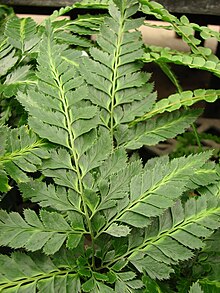Fern family
| Fern family | ||||||||||||
|---|---|---|---|---|---|---|---|---|---|---|---|---|

Common fern ( Dryopteris filix-max ) |
||||||||||||
| Systematics | ||||||||||||
|
||||||||||||
| Scientific name | ||||||||||||
| Dryopteridaceae | ||||||||||||
| Herter |
The worm fern family (Dryopteridaceae) are a family of the real ferns (Polypodiopsida).
features
The family is characterized by creeping, ascending or upright, sometimes climbing rhizomes . There are scales at the top. The leaf stalks have numerous round vascular bundles , which are arranged in a ring. The leaf blades are uniform (monomorphic), rarely there are two types of blades (dimorphic). Sometimes the blades are covered with scales or glands, rarely with hair . The leaf veins are pinnate or bifurcated, free or connected by various forms of anastomoses (cross connections).
The Sori are typically round, the Indusium is round to kidney-shaped, even absent in several clans. The sporangia are stalked short to long. The spores are kidney-shaped, monolet (a scar) and have a winged perispora (outermost, subsequently deposited layer of the spore wall).
The basic number of chromosomes in most of the genera examined is x = 41, in rare cases that are regarded as derived, 40.
distribution
The family is mainly spread pantropically, but occurs with many representatives in temperate areas. They grow terrestrially , on rocks, hemiepiphytically or epiphytically .



Systematics
The extent of the Dryopteridaceae is handled very differently depending on the author. Some authors also put representatives of the families Tectariaceae , Woodsiaceae and Onocleaceae to the worm fern family. To the extent that Smith et al. In 2006, the fern family are almost certainly monophyletic , provided Didymochlaena , Hypodematium and Leucostegia are excluded from the family. With these, she may be paraphyletic , but there was insufficient data to separate her from the family.
The fern family include, according to Smith et al. around 40 to 45 genera with a total of 1700 species, 70 percent of which belong to the four genera Ctenitis , Dryopteris , Elaphoglossum and Polystichum . The worm fern family includes Pryer et al. according to the representatives of the families Aspidiaceae, Bolbitidaceae, Elaphoglossaceae, Hypodematiaceae and Peranemataceae, which other authors consider to be independent.
The genres are in alphabetical order:
- Acrophorus C. Presl , with two to seven species between Southeast Asia and the Fiji Islands.
- Acrorumohra (H. Ito) H. Ito , with about four species in East Asia.
- Adenoderris J. Sm. , With three species in the Caribbean.
- Arachniodes flower , with over 100 species in the tropics.
- Ataxipteris Holttum , with up to two species in East Asia, but which are also referred to as ctenitis .
- Bolbitis Schott (incl. Egenolfia Schott ), water fern with at least 58 species in the tropics.
-
Coveniella Tindale , with only one species in Australia:
- Coveniella poecilophlebia (Hook.) Tindale
- Ctenitis (C. Chr.) Tard. & C. Chr. , With over 100 to about 150 species in the tropics.
- Cyclodium C. Presl , with about nine species in the tropics.
- Cyrtogonellum Ching , with about seven species.
- Cyrtomidictyum Ching , with four species in East Asia.
- Sickle ferns ( Cyrtomium C. Presl ), with about 40 species.
- Didymochlaena Desv. , with about 2–4 species in the tropics.
-
Dryopolystichum Copel. , with only one species in New Guinea:
- Dryopolystichum paheostigma (Ces.) Copel.
- Dryopsis Holttum & PJ Edwards , with about 20 species.
- Common ferns ( Dryopteris adans. , Incl. Nothoperanema (Tagawa) Ching ), with over 250 species.
- Elaphoglossum Schott ex J. Sm. , With over 400 species. ( incl.Microstaphyla C. Presl )
- Hypodematium Kunze , with about three to eleven species.
- Lastreopsis Ching , with around 30 species especially in Australia.
- Leucostegia C. Presl , with two species that occur between Indomalesia and Vanuatu .
-
Lithostegia Ching , with only one species that occurs between the eastern Himalayas and southwest China:
- Lithostegia foeniculacea (Hook.) Ching
- Lomagramma J. Sm. , With about 9-18 species from Indomalesia to the Pacific Islands.
-
Maxonia C. Chr. , With only one species in the West Indies and in South America:
- Maxonia apiifolia (Sw.) C. Chr.
- Megalastrum Holttum , with about 45 species, mainly in America.
- Oenotrichia Copel. , with three to four species in New Guinea, New Caledonia and tropical Australia.
- Olfersia Raddi , with about two species in the Neotropic.
- Peranema D. Don , with about five species in South Asia and Indomalesia.
- Phanerophlebia C. Presl , with at least 11 species.
- Polybotrya Humb. & Bonpl. ex Willd. , with at least 25 species in tropical America.
- Polystichopsis (J. Sm.) Holttum , with about three to four species in tropical America.
- Shield ferns ( Polystichum Roth , including Papuapteris C. Chr. , Plecosorus Fée ), with at least 200 species.
-
Revwattsia D.L. Jones , with only one species in Australia:
- Revwattsia fragilis (Watts) DL Jones
- Rumohra Raddi , with around three to five species in Africa, Madagascar, Asia, Australia, New Guinea, New Zealand, Polynesia, Central and South America.
-
Stenolepia Alderw. , with only one species in Malesia:
- Stenolepia tristis (flower) Alderw.
- Stigmatopteris C. Chr. , With about 25 species in tropical America.
- Teratophyllum Mett. ex Kuhn , with about 9–12 species in Malesia and New Caledonia.
literature
- Alan R. Smith, Kathleen M. Pryer, Eric Schuettpelz, Petra Korall, Harald Schneider, Paul G. Wolf: A classification for extant ferns. In: Taxon. Volume 55, No. 3, 2006, ISSN 0040-0262 , pp. 705-731, abstract, PDF file .
- David J. Mabberley: The Plant Book. A portable dictionary of the higher plants. Cambridge University Press, Cambridge 1987, ISBN 0-521-34060-8 .
Individual evidence
- ↑ Christel Kasselmann : aquarium plants . Ulmer Verlag, Stuttgart 1995; 2nd edition 1999, ISBN 3-8001-7454-5 , pp. 153 f.



